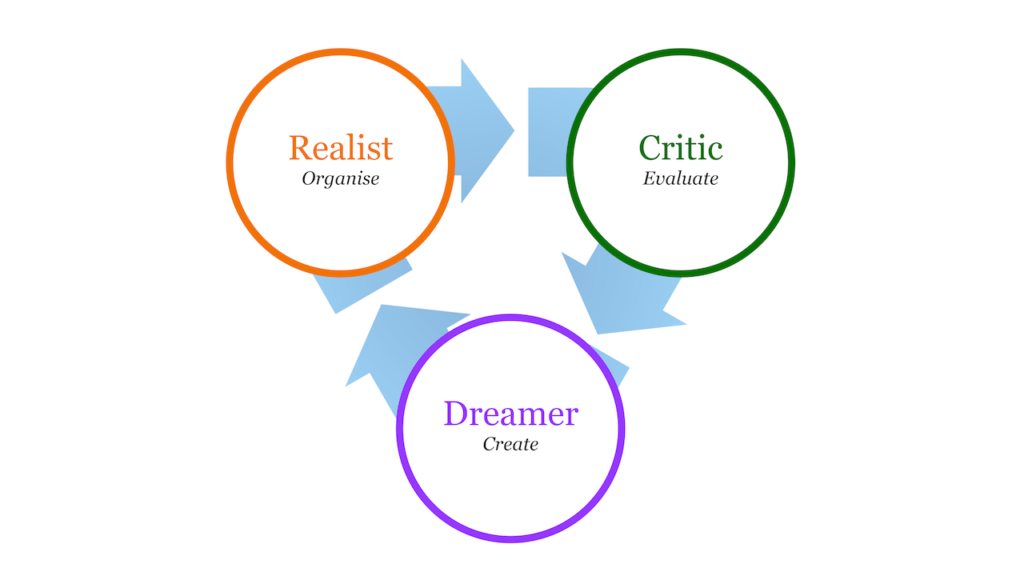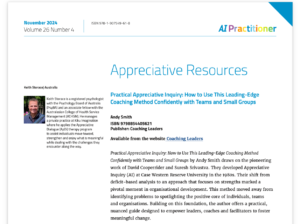How to Use the Disney Strategy for Creativity in the Design Stage

[ad_1]

A simple idea generation method that you can use in any kind of one-to-one coaching
In the Design stage of appreciative coaching, we are looking for the client to come up with choices and possible actions that will help them move closer to the vision they imagined in the preceding Dream stage – either new ideas, or something that has worked for them previously that they might have forgotten about.
Although the client will, we hope, still be in a ‘generative’ state – more creative and more accepting of new ideas – from the previous stages of coaching, it’s nonetheless useful to have a structured method for helping them get past the ‘realism’ or maybe even ‘learned helplessness’ that may have characterised their thinking previously. There is a place for considering whether an idea will work in practice, or what could go wrong with it, but if it comes into play too early in the creative process, the client’s creative aspect will quickly shut down and the wellspring of ideas will dry up.
If you don’t already have an ideation method that you’ve found works well for your coaching clients, you may like to try this one – the ‘Disney Strategy for Creativity’. We’ve all encountered the “Yeah, great idea, but it won’t work because…’ stumbling block when we’ve been trying to come up with ideas – whether from other people or from our own ‘inner critic‘.
Apparently the great animator Walt Disney found a way to get round this objection as his creative team worked on developing the next movie. The process was ‘modelled’ by NLP pioneer Robert Dilts and outlined in his book Strategies of Genius Volume 1. The basic principle is to separate out the creative process into stages so that the initial flowering of creativity – which works by association rather than logic – is not stamped out by looking for flaws prematurely.
The first stage is the ‘Dreamer’ stage (no relation to the Dream stage in Appreciative Inquiry). In this stage, encourage the client to think of as many ideas as possible, without worrying about quality control, and – crucially – without having to commit to or defend any of them, so as not to inhibit the creative process. You can tell the client that all ideas are good ideas, and that the aim is to create a big a pool of ideas to choose from in the next stage – the more the better. Make a note of each idea as it comes up and move on to the next one – or have an automated transcription service note them down in real time.
The second stage is the ‘Realist’ or ‘Implementer’ stage. In this stage, the client selects their favourite ideas (ideally there will be some that just jump out at them) and consider the question “What do you have to do in practice to bring this idea into reality?” Note that this is not the same as looking for what could go wrong – that happens in the final stage.
In the third ‘Critic’ stage, finally we get to search for flaws. The questions to ask here are, “What could go wrong? What do you need to keep an eye on?” and perhaps “What unexpected difficulties could happen?”
If any faults are identified with the chosen ideas, the client can go round the cycle again and dream up fixes for them, consider how these fixes can be implemented in the real world, and check that they do in fact fix the problems identified and that they haven’t introduced any new ones. You can go round the cycle of Dreamer -> Implementer -> Critic as many times as the client needs to until they’re happy with the way forward.
Breaking down the idea generation process into these three stages means that the favoured ideas get a chance to develop a bit and become more robust before they are hit with objections. Making it clear that the client doesn’t have to commit to or defend any of the ideas in the Dreamer stage should remove at least some of the client’s ‘inner critic’ to find fault with them straight away.
It’s worth pointing out what readers already familiar with Appreciative Inquiry may have spotted already: that the Disney Strategy, because it moves from pure idea generation into considering implementation steps and checking for what could go wrong, actually overlaps with some of the next stage, Delivery (or ‘Destiny’). That’s actually useful in one-to-one coaching, as it provides a smooth transition from one stage to the next.
You could use the Disney Strategy in any kind of one-to-one coaching. The format works just as well for group coaching or running a 4-D cycle with a team. I’ve outlined some different ways you could organise the process in the ‘Design Stage’ chapter in the Practical Appreciative Inquiry book, which focuses on working with teams and small groups.
[ad_2]




